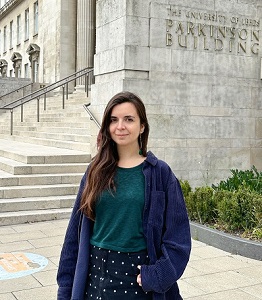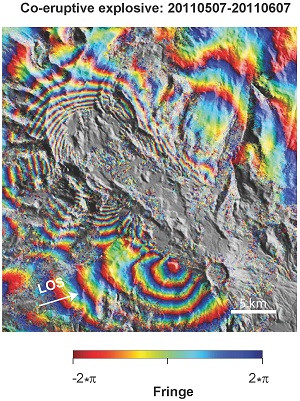- News
- Meet a young researcher who st...
Meet a young researcher who studies the behaviour of volcanoes worldwide
22 Sep 2022
Researcher Camila Novoa Lizama, of the University of Leeds, recently analysed how the use of Synthetic Aperture Radar (SAR) imagery over the Puyehue Cordón-Caulle Volcanic Complex, in Chile, acquired by ALOS-1, Envisat and the Copernicus Sentinel-1 satellites, helped her team to better comprehend the temporal and spatial behaviour of ground displacements before, during and after the volcano’s last eruption.
What triggers a magmatic eruption is one of the biggest challenges in volcanic hazard assessment. Although the 2011-2012 Cordon Caulle eruption in Chile, one of the largest of the 21st century, has been widely monitored by geodetic and seismological data, its trigger remains undetermined.
The eruption was characterised by a rapid change from explosive to effusive behaviour and showed no signs of ground deformation in the two years prior to its occurrence.

Camila's research reveals how Envisat imagery was key to investigating the possible triggers of this eruption: a magnitude 5 earthquake could have altered the stress state of the volcanic complex, inducing dilation of the host rock above the reservoir, allowing magma to flow from the reservoir to the surface. Along with Envisat images, those from other satellites allowed her and her team to study the evolution of surface displacements over the complete eruptive cycle of this volcano—such as ALOS-1 for the pre-eruptive period and Copernicus Sentinel-1 for the post-eruptive period.
Born in 1990, in Chile, Camila finished her studies of Geophysics at the University of Concepcion in 2015, and then went to France in 2017, to do her doctoral studies at the Géosciences Environnement Toulouse (GET) laboratory, associated with the Paul Sabatier University.
In Toulouse, she learned the Interferometric synthetic-aperture radar (InSAR) technique, as well as numerical modelling that she applied to study volcanoes. In particular, she studied some volcanoes in Chile during her PhD and now she is working on the DEEPVOLC project, at the University of Leeds, whose main aim is to monitor and forecast activity at all the volcanoes around the world.
ESA: How and when did you decide you wanted to focus on Earth Observation?
Camila: Although you might think it is a predictable decision, since I live in Chile, a country full of earthquakes and volcanic eruptions, the decision was not obvious. In my country, we are used to these phenomena and we don't think about them like people in Europe do. For us, earthquakes are a normality that we are accustomed to and we aren’t surprised until something huge happens, like the earthquake in Maule in 2010, with an 8.8 magnitude. I could say that to some extent this earthquake is what motivated me to study Earth science, as it occurred very close to my city. But, beyond that, by focusing on science and academia, I was also trying to escape an industry (that where most geophysicists are employed in Chile) that has produced a lot of damage to the environment.
Getting into science, and more specifically into Earth observation, was a progressing discovery that I enjoyed as I learned more. As part of my undergraduate thesis, I worked on a mechanical seismic coupling model to identify and predict the most likely locations for future earthquakes in Chile. This project made me realise there is an enormous potential for satellite observations in solving applied Earth science research questions. It was this study, along with my supervisor’s motivation to pursue science, that eventually led me to continue studying Earth.
ESA: How did you start/choose to study volcanoes?
Camila: I had planned to continue working on earthquakes after my undergraduate degree, but an opportunity came up to study volcanoes with a team in France. The idea was to use satellite radar interferometry to monitor changes in the topography of Chile's volcanoes, and relate them to processes that might be occurring in the volcanic system at depth, such as determining whether any volcano where there’s evidence of magma rising to the surface is a candidate for eruption.
The project attracted me because, until then, there were no Chilean researchers using this technique and it was very promising for the study of volcanoes since it allowed remote monitoring and did not depend on the availability of instruments in situ on volcanoes, which in many cases are very remote and difficult to access.
Furthermore, from a social point of view, research on the prediction of eruptions helps to avoid major disasters, and improve accuracy of early warning and the consequent timely evacuation of people and livestock.
These reasons motivated me to apply for a scholarship offered by the Chilean government to pursue PhD studies abroad, and eventually, led me to the current position I have at the University of Leeds, where not only am I studying volcanoes in Chile, but also those all around the world.

ESA: How did your studies help you to approach this particular project?
Camila: My background in geophysics gave me the knowledge of mathematics and physics, required to understand these techniques. Then, the expertise I obtained in France, on numerical modelling and SAR image processing, allowed me to further apply them specifically to the study of volcanoes.
Finally, to carry out this project in the Cordon Caulle volcanic Complex, the collaboration with Chilean colleagues, specialists in the geology and volcanology of the area, was fundamental for the correct interpretation of the data presented in this specific article.
ESA: How did the use of the combined data from the mentioned missions help to reveal important information on the volcanic complex?
Camila: To be able to work with this InSAR technique, the first thing one needs is a satellite with a radar. The advantage of working with different missions is that they allow us to study the behaviour of the volcano at different times, in this case (the Puyehue Cordon Caulle volcanic complex) over a 10 year period.
In the cited volcanic complex, we currently have Copernicus Sentinel-1 making observations every 12 days, however, this mission only started in 2014, and the eruption of this volcano took place in 2011. Therefore, the measurements made by ALOS-1 before the eruption, and the Envisat measurements taken during the eruption, were essential to understand the full eruptive cycle of this volcano.
ESA: Any last thought on your overall experience?
Camila: My experience in Europe, both during my PhD in France and in my current work in the UK, has been very rewarding in every way. I have learned a lot about satellite monitoring with InSAR, as well as about volcanoes, but also about the difference in the way science is studied in the first and third world. One of the questions I have been asked most often over the years about my work is why a Chilean, with all the volcanoes we have, comes to Europe, where there are not many active volcanoes, to study them. And although in Chile we have a whole natural laboratory to study these phenomena, the State is unable to provide the scientific funds necessary to advance in the knowledge and development of this type of technique.
The fact that ESA is providing free satellite images for research, and that teams like the one I am currently working with at the University of Leeds are providing totally free tools to calculate interferograms with Copernicus Sentinel-1, opens the way for ideas from all over the world to come in to advance the second stage of research of such phenomena, which is to understand what processes explain Earth observations, thus advancing the prevention of future volcanic eruptions.
I think that South Americans like myself have great potential to contribute in this area, because we live in a place where we have developed the habit of looking for solutions, therefore, making us instinctively creative and resourceful.
I hope that in the future my country will realise that research is the path to development and so will invest more in it, providing a better quality of life for all, so that others like me are given this opportunity.